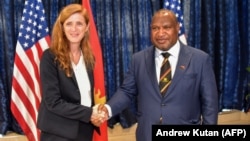In a push to strengthen the partnership between the United States and the islands of the South Pacific, President Joe Biden hosted the first-ever United States-Pacific Island Country Summit.
At the time, President Biden promised to elevate USAID’s presence in Papua New Guinea.
In mid-August, USAID Administrator Samantha Power did just that, elevating the USAID regional satellite office to a Country Representative Office. The USAID Office will continue to oversee programs in Papua New Guinea, as well as the Solomon Islands and Vanuatu.
One of USAID’s top regional priorities is to help the government of Papua New Guinea reach its goal of bringing reliable electrical power to 70 percent of its people by 2030.
Today, some three quarters of the population of Papua New Guinea lack access to reliable electricity. That lack of power carries a huge cost, setting back development profoundly. “This initiative, this program on electrification, collectively has already brought reliable electricity to about 800,000 individuals,” said USAID Administrator Power.
“We do believe [the 2030 goal] is achievable, and at the very least we think that it is the right target for us to be shooting at,” said USAID Assistant Administrator for Asia Michael Schiffer:
“Helping PNG and working with PNG as they seek to provide electricity to 70 percent of their population by 2030 is a worthwhile goal. It’s a good goal. It’s the sort of aspiration that we should have together for how to better livelihoods and how to create opportunities for economic growth, and do so in a way that is environmentally sustainable given the challenges that we face with climate change.”
“Critically for USAID, the work that we do with our partner countries is primarily grant-based, not loan-based, because we see saddling countries with unsustainable debt burdens as not being a contributing factor for sustainable economic growth,” said Mr. Schiffer. “We see that as a critical enabler, again, for sustainable economic growth over time, not just an immediate hit or sugar rush but something that can last for years in helping to provide for beneficial livelihoods.”
“It’s about our enduring commitment,” said Assistant Administrator Schiffer. “It’s about showing that we actually care and can deliver. But in the end, it’s also about making sure that we’re answering to the needs and what our partners want us to be working with them so we can actually build a good community together going forward.”














